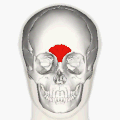Procerus muscle
| Procerus muscle | |
|---|---|
frowning | |
| Identifiers | |
| Latin | musculus procerus, pyramidalis nasi, depressor glabellae |
| TA98 | A04.1.03.008 |
| TA2 | 2061 |
| FMA | 46769 |
| Anatomical terms of muscle] | |
The procerus muscle (or pyramidalis nasi) is a small pyramidal slip of muscle deep to the
, meaning tall or extended.Structure
The procerus muscle arises by
Nerve supply
The procerus muscle is supplied by the temporal branch of the facial nerve (VII).[2] It may also be supplied by other branches of the facial nerve, which can be varied,[2] including the lower zygomatic branches. A supply from its buccal branch has also been described.[3] Its contraction can produce transverse wrinkles.
Function
The procerus muscle helps to pull that part of the skin between the eyebrows downwards, which assists in flaring the
Clinical significance
Procerus sign
Dystonia of the procerus muscle is involved in the procerus sign, which is indicative of progressive supranuclear palsy (PSP).[4]
Denervation
The procerus muscle may be denervated to reduce furrow lines around the glabella caused by frowning.[2] This may be for cosmetic purposes. Surgery can be used to transect the temporal branch of the facial nerve, although other branches of the facial nerve may also need to be cut.[2]
Additional images
-
Procerus muscle (red).
References
![]() This article incorporates text in the public domain from page 382 of the 20th edition of Gray's Anatomy (1918)
This article incorporates text in the public domain from page 382 of the 20th edition of Gray's Anatomy (1918)
- Encyclopædia Britannica 2006 Ultimate Reference Suite DVD2009
- ^ PMID 16756251.
- ^ "Nose, nasal cavity and paranasal sinuses" CHAPTER 32. Gray's Anatomy
- S2CID 42867971 – via ScienceDirect.

